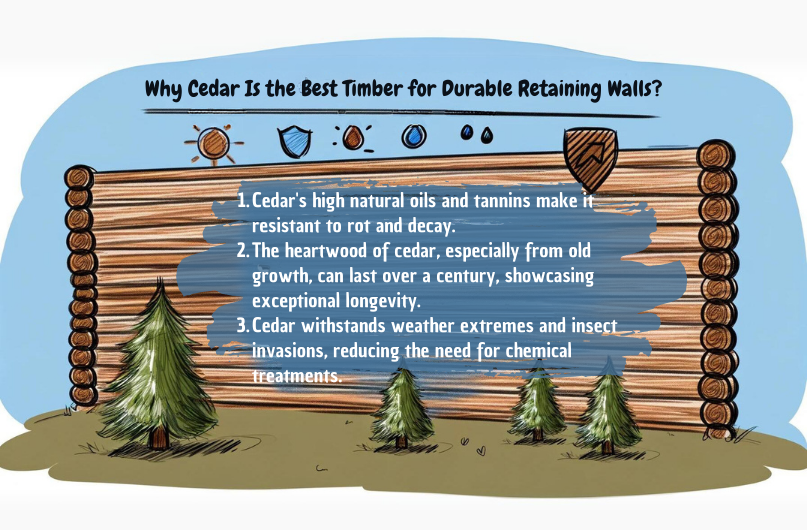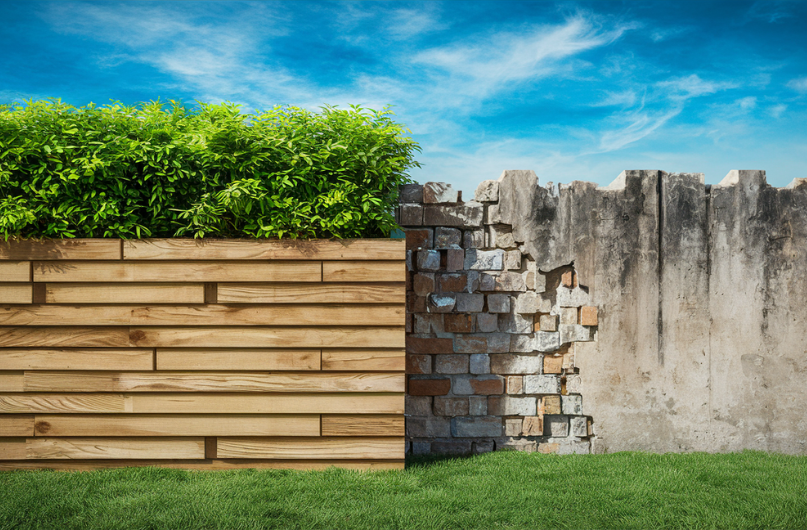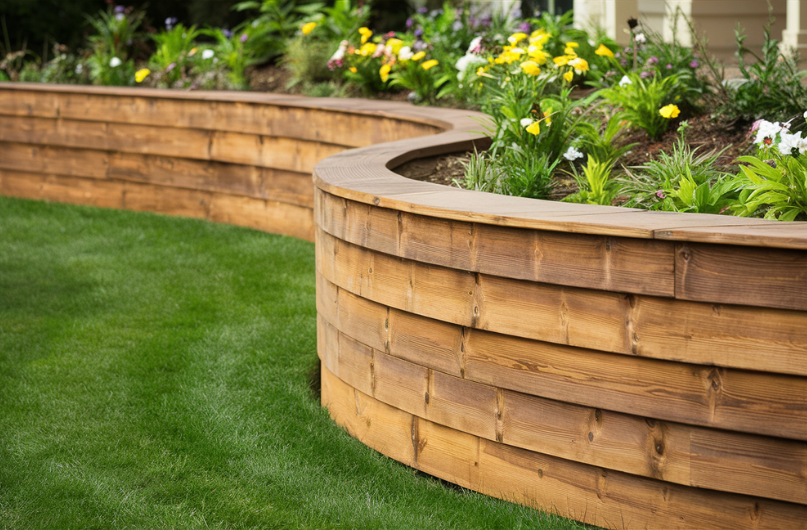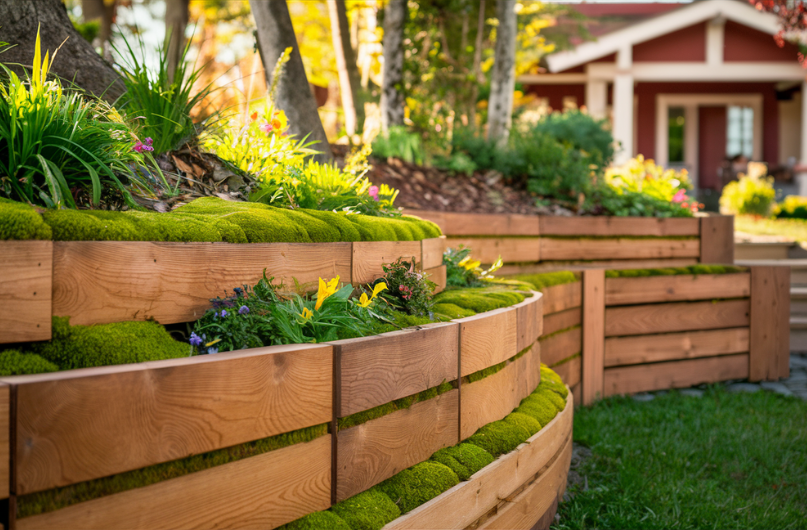Cedar is your top choice for durable retaining walls because of its lasting endurance and built-in defenses. Its heartwood, notable in old-growth red cedar, can surpass a century in durability. You'll find cedar naturally resistant to rot and decay, thanks to its high oil and tannin content, ensuring that your retaining walls maintain their structural integrity for years. Additionally, cedar excels in weathering harsh conditions and repelling insect invasions, reducing your reliance on chemical treatments. Its aesthetic versatility also enriches outdoor spaces, making it not only a practical choice but a visually appealing one. Uncovering these unique cedar qualities could greatly impact your next outdoor project.

Cedar's natural durability, particularly in old-growth red cedar, allows it to last indefinitely, underlining its exceptional longevity and resilience. This inherent quality not only showcases cedar's ability to withstand the test of time without any chemical treatment but also highlights its natural resistance against various environmental factors.
When considering cedar for constructing durable retaining walls, it's important to understand the distinction between heartwood and sapwood. The heartwood of red cedar, especially from old growth, exhibits remarkable durability, capable of lasting over a century in conditions not in direct contact with the ground.
However, cedar's sapwood contrasts sharply when it comes to longevity, as it succumbs to rot much more rapidly. This emphasizes the necessity of utilizing heartwood for projects that demand lasting strength and durability.
When cedar is deployed in applications with ground contact, treating it with wood preservatives can greatly improve its endurance, blending natural resilience with protective measures to extend its lifespan.
The environmental benefits of using cedar, a material with natural resistance, are remarkable. Opting for cedar means relying less on chemical treatments, thereby contributing to a more sustainable construction approach. Cedar's longevity reduces the need for frequent replacements, further strengthening its environmental credentials.

Given its high levels of natural oils and tannins, cedar heartwood boasts a remarkable resistance to rot and decay, making it an exemplary material for constructing durable retaining walls. These intrinsic properties of cedar not only bolster its durability and longevity in outdoor settings but also contribute to its low-maintenance and long-lasting nature without the need for chemical treatments. This aspect greatly elevates cedar's environmental benefits, aligning with sustainability goals by reducing the reliance on synthetic preservatives that can harm the ecosystem.
Furthermore, the natural resistance of cedar to rot and decay guarantees that retaining walls made from this timber maintain their structural integrity over time. This reliability translates into cost-effectiveness, as the longevity of cedar reduces the need for frequent replacements or repairs.
The ease of working with cedar, owing to its natural properties, streamlines the installation process, further boosting its cost efficiency. By choosing cedar for retaining walls, you're not only opting for a material that withstands the test of time but also embracing a solution that's both sustainable and cost-effective, epitomizing a smart investment in your project's infrastructure.

Beyond its resistance to rot and decay, cedar also stands up to the challenges posed by weather extremes and insect invasions, thanks to its natural oils and tight grain structure. These inherent qualities afford cedar unparalleled weather resilience, making it a top choice for retaining walls exposed to varying climatic conditions. Western Red Cedar, in particular, showcases exceptional durability against the harsh realities of outdoor settings, ensuring that your structure remains intact through seasons of rain, snow, and sun.
Moreover, cedar's pest protection capabilities are remarkable. Its natural oils act as a deterrent against a wide range of insects, including those that are typically problematic for timber structures, such as termites and carpenter ants. This insect-repelling property not only contributes to cedar's longevity but also minimizes the need for chemical treatments, making it a low-maintenance option for your retaining walls.

Cedar enhances outdoor spaces with its natural, warm aesthetic and unmatched versatility, enabling customization across a wide range of design styles. Its fine grain and rich color variations not only add depth and character to retaining walls but also offer you unparalleled design flexibility. Cedar's ability to blend seamlessly with both traditional and modern landscapes makes it a particularly appealing option for those aiming to achieve a specific architectural or aesthetic goal.
When considering cedar for your retaining wall projects, keep in mind these key advantages:
To ensure your cedar retaining walls stand the test of time, you'll need to commit to regular maintenance and consider the inherent longevity of the material. Western Red Cedar, particularly its heartwood, possesses a natural durability, lasting approximately five years in ground contact without any treatment. However, this lifespan can be greatly extended through meticulous care.
Cedar sapwood, on the other hand, is susceptible to rapid decay if left untreated. The application of wood preservatives is essential to safeguard this more vulnerable component. By employing sealing techniques, you effectively shield the timber from moisture and pests, pivotal factors in extending the wall's service life.
Regular inspections are essential in this maintenance regimen. They enable early detection of potential issues, such as moisture infiltration or signs of rot, allowing for timely intervention. This proactive approach not only maintains the structural integrity of your retaining walls but also maximizes their longevity.
Recognizing that old growth red cedar can last indefinitely under ideal conditions underscores the importance of maintenance. Cedar's inherent resistance to decay positions it as an excellent choice for durable retaining walls, provided it receives the necessary care.
When it comes to preserving your property's integrity and enhancing its aesthetic appeal, retaining walls play a crucial role. At Landscaping HQ, we understand the importance of quality craftsmanship and tailored solutions for your unique landscape. Here's why you should trust us with your retaining wall project:
Trust Landscaping HQ to transform your outdoor space with our exceptional retaining wall solutions.
Yes, cedar's ideal for retaining walls due to its natural resistance to rot and decay. However, consider higher installation costs and maintenance, like treating with preservatives, for best durability and to extend its lifespan.
For the best timber in retaining walls, consider cedar's superiority due to its natural durability and resistance to decay. Analyzing pressure treatment and cost comparison highlights cedar's unmatched value for long-lasting, minimal maintenance structures.
Cedar's durability stems from its natural cedar oils, providing exceptional rot resistance. Properly treated, it withstands decay, ensuring longevity even in ground contact. This characteristic makes it a superior choice for various construction projects.
Cedar wood offers significant advantages, including its distinct aroma and robust insect resistance. Its inherent preservative oils contribute to its durability, making it an excellent choice for applications requiring long-term resilience and strength.
To sum up, you've seen why cedar stands out as the superior timber for durable retaining walls. Its natural durability, resistance to rot and decay, coupled with its formidable defense against weather and insects, not only guarantees longevity but also adds aesthetic appeal and versatility to your landscape.
Also, its low maintenance requirement further solidifies cedar's position as the go-to material. Analyzing these technical aspects, it's evident that cedar offers a precise and efficient solution for enduring retaining wall construction.